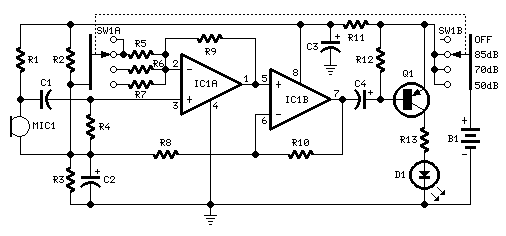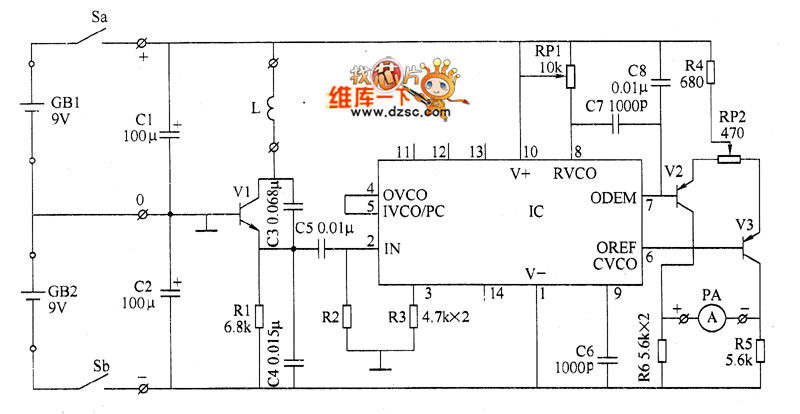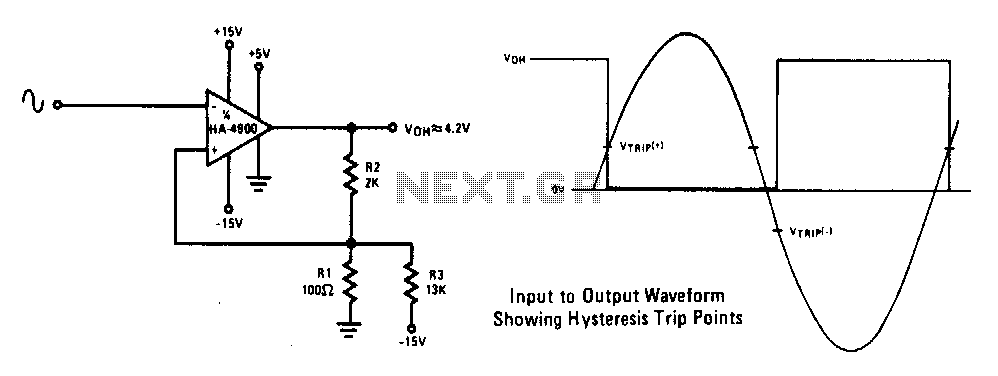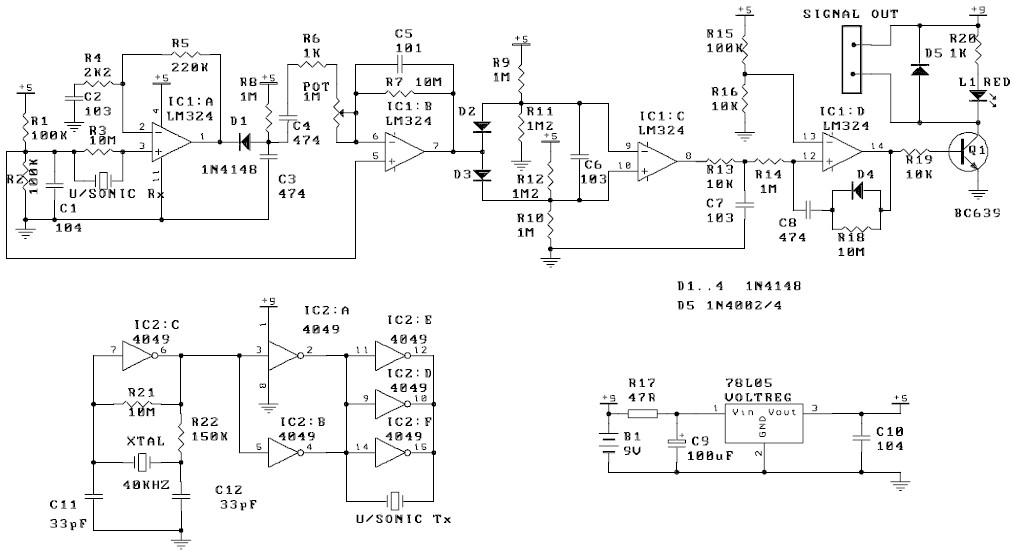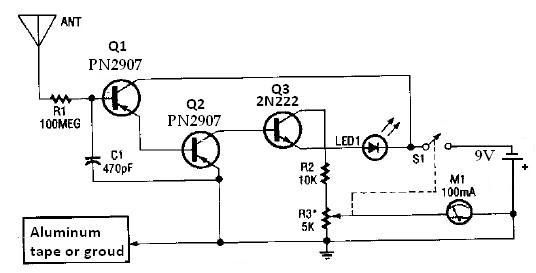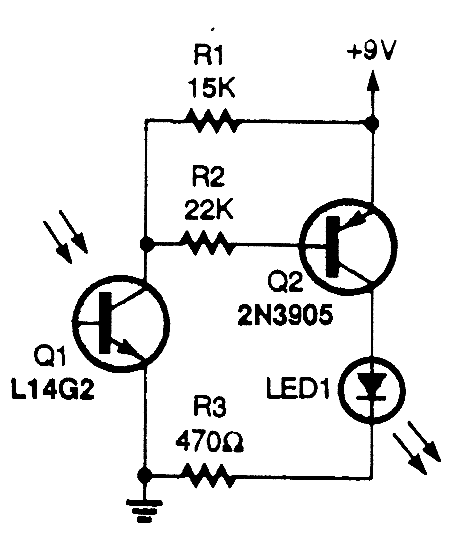
plant watering watcher dry soil detector
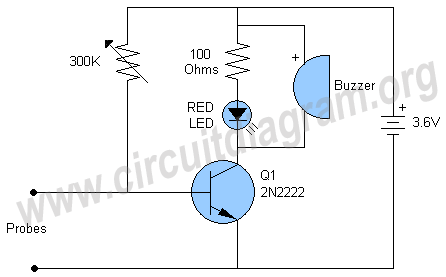
The schematic presented is a circuit designed for monitoring plant watering, also known as a dry soil detector. Indoor plants, whether in homes or offices, require more attention compared to outdoor plants. Due to busy schedules, it is common to forget to water indoor plants, leading to dryness and poor health. This circuit serves as a useful reminder to water plants. It emits a beep and activates an LED when the two probes fail to detect moisture in the soil. A 300K variable resistor is incorporated to set the activation level for the buzzer and LED based on the desired soil dryness. To calibrate the circuit, insert the two probes into moist soil and adjust the variable resistor until the LED and buzzer turn off. After calibration, remove one probe from the soil; if the LED and buzzer activate, the circuit is properly adjusted and ready for use.
The plant watering watcher circuit employs a simple yet effective design to ensure that indoor plants receive adequate moisture. It typically consists of two metal probes that serve as moisture sensors. When inserted into the soil, these probes complete a circuit that allows current to flow based on the moisture level present. In dry soil conditions, the resistance between the probes increases, leading to a voltage change that is detected by the circuit.
The core component of this circuit is the operational amplifier or comparator, which compares the voltage from the probes against a reference voltage set by the variable resistor. When the soil moisture level drops below the predefined threshold, the output of the comparator changes state, triggering the buzzer and illuminating the LED. This visual and auditory alert serves as a reminder for the user to water the plants.
The 300K variable resistor plays a crucial role in adjusting the sensitivity of the circuit. By tuning this resistor, the user can set the threshold at which the circuit activates. This adjustability is essential, as different types of soil and plant species may require varying moisture levels. The calibration process outlined ensures that the circuit operates accurately, providing reliable alerts when the soil becomes too dry.
In summary, this plant watering watcher circuit is an essential tool for anyone managing indoor plants. Its straightforward design, combined with adjustable sensitivity, makes it an effective solution for preventing plant neglect and ensuring optimal growth conditions.The schematic shown here is a circuit of plant watering watcher or dry soil detector. The plants located in your home or office wants more care as compare to the plants outside. We often forget to water the plants in our home and offices due to load of work and as a result our plants become dry and unhealthy. The circuit shown here is a very usefu l device for reminding to water your plant. The circuit will give a beep and activate an LED when the two probes will not detect any moisture in the soil. The 300K variable resistor is used to activate the buzzer and LED on the desired level of soil dryness.
To adjust the circuit, insert the two probes when the soil is moist and slightly adjust the variable resistor until the LED and buzzer goes off, after that take out one probe from the soil, if the LED and the buzzer will activate that means your circuit is adjusted and ready for use. 🔗 External reference
The plant watering watcher circuit employs a simple yet effective design to ensure that indoor plants receive adequate moisture. It typically consists of two metal probes that serve as moisture sensors. When inserted into the soil, these probes complete a circuit that allows current to flow based on the moisture level present. In dry soil conditions, the resistance between the probes increases, leading to a voltage change that is detected by the circuit.
The core component of this circuit is the operational amplifier or comparator, which compares the voltage from the probes against a reference voltage set by the variable resistor. When the soil moisture level drops below the predefined threshold, the output of the comparator changes state, triggering the buzzer and illuminating the LED. This visual and auditory alert serves as a reminder for the user to water the plants.
The 300K variable resistor plays a crucial role in adjusting the sensitivity of the circuit. By tuning this resistor, the user can set the threshold at which the circuit activates. This adjustability is essential, as different types of soil and plant species may require varying moisture levels. The calibration process outlined ensures that the circuit operates accurately, providing reliable alerts when the soil becomes too dry.
In summary, this plant watering watcher circuit is an essential tool for anyone managing indoor plants. Its straightforward design, combined with adjustable sensitivity, makes it an effective solution for preventing plant neglect and ensuring optimal growth conditions.The schematic shown here is a circuit of plant watering watcher or dry soil detector. The plants located in your home or office wants more care as compare to the plants outside. We often forget to water the plants in our home and offices due to load of work and as a result our plants become dry and unhealthy. The circuit shown here is a very usefu l device for reminding to water your plant. The circuit will give a beep and activate an LED when the two probes will not detect any moisture in the soil. The 300K variable resistor is used to activate the buzzer and LED on the desired level of soil dryness.
To adjust the circuit, insert the two probes when the soil is moist and slightly adjust the variable resistor until the LED and buzzer goes off, after that take out one probe from the soil, if the LED and the buzzer will activate that means your circuit is adjusted and ready for use. 🔗 External reference
